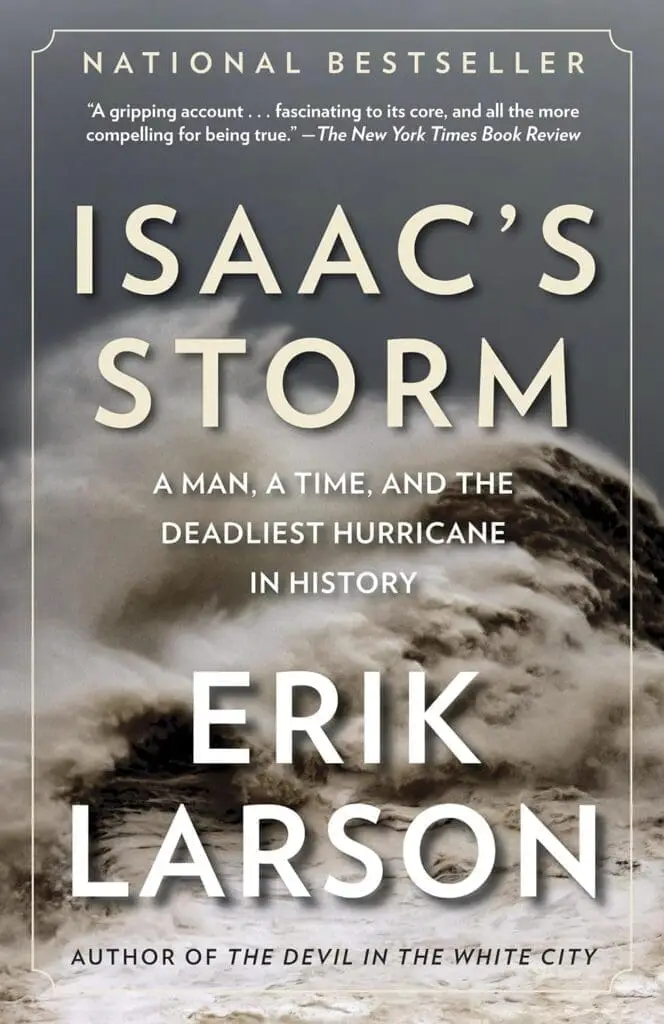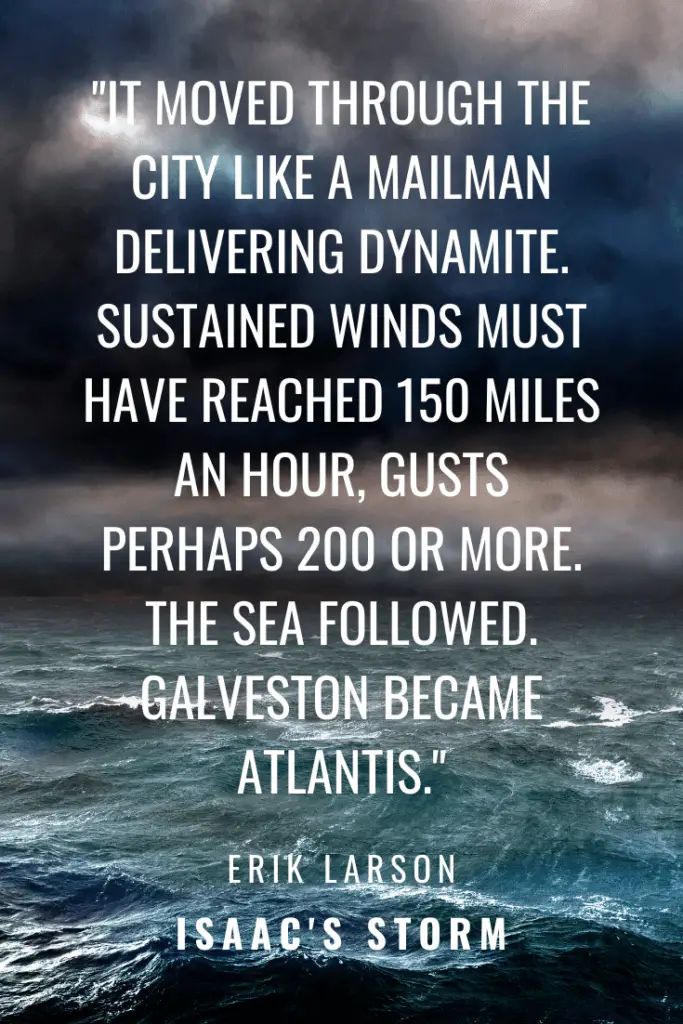Jump to Quotes
I just spilled two cups of water on my bedside table.
My Kindle, new paperback book of poems, blog calendar planner, phone, and the hems of my pants are all now drenched in cucumber water I had been infusing all day.
As I scramble to grab towels and mop up what seems like a gallon of cucumber-scented water now streaming to the floor, I think, it’s amazing how such a small amount of water can be so destructive.
Ever since I finished reading Isaac’s Storm by Erik Larson, I’ve had water on the brain.

This post may contain affiliate links, meaning if you click them I could earn a small commission at no extra cost to you. Thank you!
Isaac’s Storm Quotes
Larson’s book gives an in-depth account of the Galveston Hurricane of 1900 that claimed at least 6,000 lives, but possibly as many as 10,000. But numbers alone can sometimes numb us to what actually happens during a catastrophic hurricane or any disaster, natural or man-made.
What sets Larson’s books apart from so many other authors is his attention to the individuals who lived these moments of history. Told primarily from the perspective of Galveston’s chief meteorologist at the time, Isaac Cline, Isaac’s Storm weaves the history of meteorology into the stories of the people who lived and died on that August day.
34 Isaac’s Storm Quotes (with page numbers)
“To Isaac, such quirks of weather were a fascination, and not just because he happened to be the chief weatherman in Texas. He was also a physician. He no longer saw patients, but had become a pioneer in medical climatology, the study of how weather affects people, and in this carried forth a tradition laid down by Hippocrates, who believed climate determined the character of men and nations.” Erik Larson, Isaac’s Storm pg 6.
“He had stumbled into the deadliest storm ever to target America. Within the next twenty-four hours, eight thousand men, women, and children in the city of Galveston would lose their lives. The city itself would lose its future. Isaac would suffer an unbearable loss. And he would wonder always if some of the blame did not belong to him. This is the story of Isaac and his time in America, the last turning of the centuries, when the hubris of men led them to believe they could disregard even nature itself.” Erik Larson, Isaac’s Storm pg. 16
“IN GALVESTON, THE humidity was nearly one 100 percent. To move was to drip. It was too hot to put on a bathing suit. “Brown is the new color for bathing suits,” the Galveston News reported in the caption of a photograph showing the latest in coastal chic. “This one of a rich leaf brown mohair has yoke, collar and bands of white mohair striped with black braid.” Mohair.” Erik Larson, Isaac’s Storm pg. 25
“Some critics argued men should not try to predict the weather, because it was God’s province; others that men could not predict the weather, because men were incompetent.” Erik Larson, Isaac’s Storm pg. 31
“There were many things you could be in the new America, but a coward was not one of them.” Erik Larson, pg. 32
“Meteorology was an emerging science rooted not so much in rigorous research as in stories and adventures, which only enhanced the mystery.” Erik Larson, Isaac’s Storm pg. 37
“It was Piddington who coined the word cyclone, from the Greek for “coils of a snake,” and it was his research that resonated most darkly within Isaac Cline on Saturday, September 8, 1900.” Erik Larson, Isaac’s Storm pg. 53
“In this staunch, straight-backed time when a man could not weep and a woman could not smoke, there was always dancing.” Erik Larson, Isaac’s Storm pg. 67
“Two months later, a blizzard swept much of the South. Icebergs ten feet high flowed down the Mississippi past New Orleans. The sudden cold killed participants in the Mardi Gras parade.” Erik Larson, Isaac’s Storm pg. 76
“Once again, they tailored fact to suit their expectations. They knew just enough to believe they had nothing to fear.” Erik Larson, Isaac’s Storm pg. 112
“THE TRANSFORMATION WAS stunning: One moment a nondescript tropical storm, the next, a hurricane of an intensity no American alive had ever experienced. The storm did not grow through some gradual accretion of power; it exploded forth like something escaping from a cage.” Erik Larson, Isaac’s Storm pg. 119
“The bureau’s West Indies service was so busy trying to downplay the danger and show up the Cubans that it apparently missed whatever signs the Cubans saw that convinced them the storm had suddenly become more violent.” Erik Larson, Isaac’s Storm pg. 141
“DOWNTOWN, IT WAS business as usual. Women seemed to understand that something exceptional was occurring, but the men of Galveston went to great lengths to deny the strange feel of the day.” Erik Larson, Isaac’s Storm pg. 150
“Suddenly the prospect of watching their children die became very real. Whom did you save? Did you seek to save one child, or try to save all, at the risk ultimately of saving none? Did you save a daughter or a son? The youngest or your firstborn? Did you save that sun-kissed child who gave you delight every morning, or the benighted adolescent who made your day a torment—save him, because every piece of you screamed to save the sweet one? And if you saved none, what then? How did you go on?” Erik Larson, Isaac’s Storm pg. 181
“ALL OVER GALVESTON, there was a need for light. A craving. People needed light for themselves to ease their fears, but they also needed others to know they were still in their homes and alive. Throughout Galveston, lamps bloomed in a thousand second-floor windows. We’re here, they said. Come for us. Please.” Erik Larson, Isaac’s Storm pg. 183
“The hurricane had set a course toward Galveston soon after leaving Cuba, and had stayed on that course ever since, as if it had chosen Galveston as its target.” Erik Larson, Isaac’s Storm pg. 193

“It moved through the city like a mailman delivering dynamite. Sustained winds must have reached 150 miles an hour, gusts perhaps 200 or more. The sea followed. Galveston became Atlantis.” Erik Larson, Isaac’s Storm pg. 198
“A single cubic yard of water weighs about fifteen hundred pounds. A wave fifty feet long and ten feet high has a static weight of over eighty thousand pounds. Moving at thirty miles an hour, it generates forward momentum of over two million pounds, so much force, in fact, that at this point during the storm the incoming swells had begun destroying the brand-new artillery emplacements at Fort Crockett, which had been designed to withstand Spanish bombardment.” Erik Larson, Isaac’s Storm pg. 200
“One man reported dodging a giant piano embedded in the crest of a wave, “its white keys gleaming even in the darkness.” Erik Larson, Isaac’s Storm pg. 200
“ALL OVER GALVESTON freakish things occurred. Slate fractured skulls and removed limbs. Venomous snakes spiraled upward into trees occupied by people. A rocket of timber killed a horse in midgallop.” Erik Larson, Isaac’s Storm pg. 202
“The storm advanced through the building quickly and systematically, as if hunting the children. The chapel disappeared. Windows shattered. Hallways rose and fell like drawbridges. The children sang.” Erik Larson, Isaac’s Storm pg. 213
“A child’s rocking horse stood by itself on a low rise, no house in sight. “And so help me,” Sterett said, “I would rather have seen all the vessels of the earth stranded high and dry than to have seen this child’s toy standing right out on the prairie, masterless.” Erik Larson, Isaac’s Storm pg. 227
“What was so striking about the dead was their battered condition. Their bodies had been stripped naked.” Erik Larson, Isaac’s Storm pg. 228
“In the wreckage, he saw striped dresses, black suits, black hats, straw boaters. He looked more closely. Some of the clothing covered battered limbs. The dead lay camouflaged under bruises, mud, and shredded cloth, but having spotted one corpse, he now saw many.” Erik Larson, Isaac’s Storm pg. 231
“One hundred corpses hung from a grove of salt cedars at Heard’s Lane. Some had double-puncture wounds left by snakes. Forty-three bodies were lodged in the cross braces of a railroad bridge.” Erik Larson, Isaac’s Storm pg. 231
“You will hear people talk without emotion of the loss of those nearest to them,” Father Kirwin said. “We are in that condition that we cannot feel.” Erik Larson, Isaac’s Storm pg. 234
“In the absence of a body, there was always hope. Isaac continued his search. But as conditions worsened—as fears of disease grew and as more and more corpses turned up (among them Anna Muat’s)—the hunt for miracles and bodies became more complicated. Hope receded, and simple emptiness took its place.” Erik Larson, Isaac’s Storm pg. 237
“At dawn the men began attaching weights to the bodies—anything that would sink. Portions of rail. Sash weights from windows. They worked quickly. Too quickly, apparently, for by the end of the day bodies began returning to Galveston. The sea drove scores of them back onto the city’s beaches. Some had weights attached; some did not.” Erik Larson, Isaac’s Storm pg. 240
“The dead gangs worked thirty-minute shifts, and in between were allowed all the whiskey they needed to keep going.” Erik Larson, Isaac’s Storm pg. 240
“Burning did not seem much of an improvement over the parade of corpse-filled wagons. The idea of burning the bodies of men, women, and children—especially children—was jarring. It seemed like sacrilege.” Erik Larson, Isaac’s Storm pg. 241
“But this storm had dragged him to its heart and changed his life forever. As he sat down opposite his typewriter, human ash dusted each fresh sheet of paper.” Erik Larson, Isaac’s Storm pg. 248
“But the city’s engineers, among them Colonel Robert, knew a seawall alone was not enough. They raised the altitude of the entire city. In a monumental effort, legions of workmen using manual screw jacks lifted two thousand buildings, even a cathedral, then filled the resulting canyon with eleven million pounds of fill. The task, completed in 1910, had an unintended benefit: It ensured that all corpses still buried within the city remained well interred.” Erik Larson, Isaac’s Storm pg. 265
“Time lost can never be recovered,” he said, “and this should be written in flaming letters everywhere.” Erik Larson, pg. 272
“Once, in a time long past when men believed they could part mountains, a very different building stood in the Wal-Mart’s place, and behind its mist-clouded windows ninety-three children who did not know better happily awaited the coming of the sea.” Erik Larson, Isaac’s Storm pg. 273